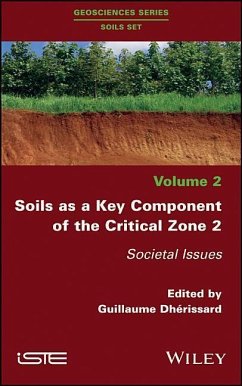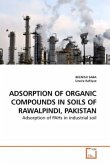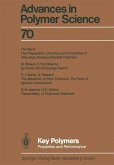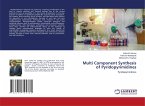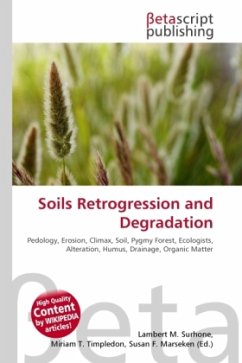Soils as a Key Component of the Critical Zone 2
Societal Issues
Herausgeber: Dhérissard, Guillaume
Soils as a Key Component of the Critical Zone 2
Societal Issues
Herausgeber: Dhérissard, Guillaume
- Gebundenes Buch
- Merkliste
- Auf die Merkliste
- Bewerten Bewerten
- Teilen
- Produkt teilen
- Produkterinnerung
- Produkterinnerung
"This book provides an overview of the issues linked to better soil management. Various angles and perspectives are presented, whether those of an agronomist, lawyer, economist, landscaper or political scientist. These analyses and reflections allow us to better reflect on the status of soils within our societies, allowing us to understand their diverse roles as well as the impact of human activity. The authors' contributions focus in particular on the most appropriate conditions of governance for the management of this precious asset."--Back cover.
Andere Kunden interessierten sich auch für
![Key Elements in Polymers for Engineers and Chemists Key Elements in Polymers for Engineers and Chemists]() Key Elements in Polymers for Engineers and Chemists159,99 €
Key Elements in Polymers for Engineers and Chemists159,99 €![ADSORPTION OF ORGANIC COMPOUNDS IN SOILS OF RAWALPINDI, PAKISTAN ADSORPTION OF ORGANIC COMPOUNDS IN SOILS OF RAWALPINDI, PAKISTAN]() Beenish SabaADSORPTION OF ORGANIC COMPOUNDS IN SOILS OF RAWALPINDI, PAKISTAN32,99 €
Beenish SabaADSORPTION OF ORGANIC COMPOUNDS IN SOILS OF RAWALPINDI, PAKISTAN32,99 €![Green Process of Three-Component Prostaglandin Synthesis and Rapid 11C Labelings for Short-Lived PET Tracers Green Process of Three-Component Prostaglandin Synthesis and Rapid 11C Labelings for Short-Lived PET Tracers]() Masaaki SuzukiGreen Process of Three-Component Prostaglandin Synthesis and Rapid 11C Labelings for Short-Lived PET Tracers71,99 €
Masaaki SuzukiGreen Process of Three-Component Prostaglandin Synthesis and Rapid 11C Labelings for Short-Lived PET Tracers71,99 €![Key Polymers Key Polymers]() Key Polymers39,99 €
Key Polymers39,99 €![Key Lecture Notes on Basic Organic Chemistry Key Lecture Notes on Basic Organic Chemistry]() Kesatebrhan Haile AsressuKey Lecture Notes on Basic Organic Chemistry51,99 €
Kesatebrhan Haile AsressuKey Lecture Notes on Basic Organic Chemistry51,99 €![Multi Component Synthesis of Pyridopyrimidines Multi Component Synthesis of Pyridopyrimidines]() Sobhi M. GomhaMulti Component Synthesis of Pyridopyrimidines26,99 €
Sobhi M. GomhaMulti Component Synthesis of Pyridopyrimidines26,99 €![Soils Retrogression and Degradation Soils Retrogression and Degradation]() Soils Retrogression and Degradation22,99 €
Soils Retrogression and Degradation22,99 €-
-
-
"This book provides an overview of the issues linked to better soil management. Various angles and perspectives are presented, whether those of an agronomist, lawyer, economist, landscaper or political scientist. These analyses and reflections allow us to better reflect on the status of soils within our societies, allowing us to understand their diverse roles as well as the impact of human activity. The authors' contributions focus in particular on the most appropriate conditions of governance for the management of this precious asset."--Back cover.
Produktdetails
- Produktdetails
- Verlag: Wiley
- Seitenzahl: 176
- Erscheinungstermin: 16. Oktober 2018
- Englisch
- Abmessung: 239mm x 163mm x 15mm
- Gewicht: 408g
- ISBN-13: 9781786302168
- ISBN-10: 1786302160
- Artikelnr.: 52638996
- Herstellerkennzeichnung
- Libri GmbH
- Europaallee 1
- 36244 Bad Hersfeld
- gpsr@libri.de
- Verlag: Wiley
- Seitenzahl: 176
- Erscheinungstermin: 16. Oktober 2018
- Englisch
- Abmessung: 239mm x 163mm x 15mm
- Gewicht: 408g
- ISBN-13: 9781786302168
- ISBN-10: 1786302160
- Artikelnr.: 52638996
- Herstellerkennzeichnung
- Libri GmbH
- Europaallee 1
- 36244 Bad Hersfeld
- gpsr@libri.de
Foreword ix
André MARIOTTI
Part 1. Local and Global 1
Chapter 1. Effective Management of Agricultural Soils: A Challenge for
Society 3
Cécile CLAVEIROLE and Agnès COURTOUX
1.1. Introduction 3
1.2. Findings and issues 4
1.2.1. Ecosystem services created by the soil 4
1.2.2. The current major issues 5
1.3. Recommendations of the French Economic, Social and Environmental
Council 6
1.3.1. Developing soil knowledge tools 7
1.3.2. Protecting the land and using land planning as a preservation tool 8
1.3.3. Supporting agricultural practices that promote good soil biological
quality 9
1.3.4. Raising awareness about soil-related issues 11
1.4. Conclusion 12
1.5. Bibliography 12
Chapter 2. A New "Great Game" over the World's Arable Land? 13
Alain KARSENTY
2.1. Introduction 13
2.2. The dynamic compound that is "land grabbing" 15
2.2.1. The powers behind the phenomenon 15
2.2.2. Quantitative estimates revised downward 16
2.2.3. A predominance of food production partly due to oil palm 18
2.2.4. Host countries and the origin of investors 19
2.2.5. The nature of investors 21
2.2.6. Land-use changes 22
2.2.7. The consequences for agricultural structures 24
2.3. Does the grabbing model have a future? 26
2.3.1. Local resistance pushes for proposals for contract farming 26
2.3.2. Possible mutual gains? 28
2.3.3. Multilateral efforts to introduce a soft law 30
2.3.4. The role of public policies 31
2.4. Conclusion 32
2.5. Bibliography 34
Part 2. Different Forms of Sustainable Management 39
Chapter 3. The Soil: A Strange Legal Notion 41
Maylis DESROUSSEAUX
3.1. Introduction 41
3.2. The potential of law in the regulation of soil usage 44
3.2.1. The variability in the law's understanding of soil 44
3.2.2. The lack of ecological soil governance 47
3.3. The necessary evolution of the legal status of soil 49
3.3.1. The protection of soil habitats recognized by law for the recovery
of biodivesity 49
3.3.2. The acknowledgment of the soil as part of our common heritag 51
3.4. Conclusion 53
3.5. Bibliography 53
Chapter 4. Where is Soil in the Design and Management of Sustainable
Farming Systems? The View of an Agronomist 57
François LAURENT
4.1. Introduction 57
4.2. The soil of the agronomist: a field of diversity 58
4.3. Soil and fertility: relationships to revisit and the need for
operational knowledge 59
4.4. Agroecology and global issues: emerging needs 66
4.5. Conclusion 70
4.6. Acknowledgement 70
4.7. Bibliography 71
Part 3. Territorial Approaches 75
Chapter 5. Common Governance of Soil Quality, Complex and Multi-player
Dynamics 77
Didier CHRISTIN and Guillaume DHÉRISSARD
5.1. Introduction 77
5.2. Return to some territorial experiments 78
5.2.1. Presentation of three cases in France, the Netherlands and Belgium
79
5.2.2. Key teachings from the viewpoint of soil governance 83
5.3. Learning about soil management in terms of common management 84
5.3.1. Soil management, a complex and multi-player issue 84
5.3.2. The total quality of the soils 85
5.3.3. Common management 87
5.4. Conclusion 90
5.5. Bibliography 91
Chapter 6. Moving Discussions Toward Co-diagnostics: Progressive Approaches
93
Christine KING
6.1. Introduction 93
6.2. Scientists' proposals 94
6.2.1. Clarifying, objectifying and representing the organization and soil
quality 94
6.2.2. Increasing knowledge and awareness of the processes involved and the
provided ecosystem services 97
6.2.3. Increasing trust in models and in projections 103
6.2.4. A better policy for raising awareness and transferring knowledge 105
6.2.5. Organizing the monitoring of scientific evidence 106
6.2.6. Developing and conducting a proper monitoring system 108
6.3. The science/society discussion 109
6.3.1. More and more interactions of the subject of soil and diagnostics
109
6.3.2. Current research and the contributions of human and social sciences
116
6.4. Conclusion 119
6.5. Bibliography 120
Chapter 7. The Soil as Territorial Commons: The Point of View of a
Landscaper 127
Pierre DONADIEU
7.1. Introduction 127
7.2. Territorial and landscaped commons 128
7.2.1. Territorial commons 129
7.2.2. Landscaped commons 131
7.2.3. Territorialism or landscaping? 134
7.2.4. Conclusion 137
7.3. Building territorial commons 137
7.3.1. Separating the rights of soil usage 137
7.3.2. Land use of the Morbihan Regional Nature Park: a landscape issue for
local societies 138
7.3.3. Conserving the agricultural soil of the Pays de Caux: a common
cause? 140
7.3.4. The Perfume River in Hü (Vietnam) 141
7.4. Conclusion 144
7.5. Bibliography 145
List of Authors 149
Index 151
André MARIOTTI
Part 1. Local and Global 1
Chapter 1. Effective Management of Agricultural Soils: A Challenge for
Society 3
Cécile CLAVEIROLE and Agnès COURTOUX
1.1. Introduction 3
1.2. Findings and issues 4
1.2.1. Ecosystem services created by the soil 4
1.2.2. The current major issues 5
1.3. Recommendations of the French Economic, Social and Environmental
Council 6
1.3.1. Developing soil knowledge tools 7
1.3.2. Protecting the land and using land planning as a preservation tool 8
1.3.3. Supporting agricultural practices that promote good soil biological
quality 9
1.3.4. Raising awareness about soil-related issues 11
1.4. Conclusion 12
1.5. Bibliography 12
Chapter 2. A New "Great Game" over the World's Arable Land? 13
Alain KARSENTY
2.1. Introduction 13
2.2. The dynamic compound that is "land grabbing" 15
2.2.1. The powers behind the phenomenon 15
2.2.2. Quantitative estimates revised downward 16
2.2.3. A predominance of food production partly due to oil palm 18
2.2.4. Host countries and the origin of investors 19
2.2.5. The nature of investors 21
2.2.6. Land-use changes 22
2.2.7. The consequences for agricultural structures 24
2.3. Does the grabbing model have a future? 26
2.3.1. Local resistance pushes for proposals for contract farming 26
2.3.2. Possible mutual gains? 28
2.3.3. Multilateral efforts to introduce a soft law 30
2.3.4. The role of public policies 31
2.4. Conclusion 32
2.5. Bibliography 34
Part 2. Different Forms of Sustainable Management 39
Chapter 3. The Soil: A Strange Legal Notion 41
Maylis DESROUSSEAUX
3.1. Introduction 41
3.2. The potential of law in the regulation of soil usage 44
3.2.1. The variability in the law's understanding of soil 44
3.2.2. The lack of ecological soil governance 47
3.3. The necessary evolution of the legal status of soil 49
3.3.1. The protection of soil habitats recognized by law for the recovery
of biodivesity 49
3.3.2. The acknowledgment of the soil as part of our common heritag 51
3.4. Conclusion 53
3.5. Bibliography 53
Chapter 4. Where is Soil in the Design and Management of Sustainable
Farming Systems? The View of an Agronomist 57
François LAURENT
4.1. Introduction 57
4.2. The soil of the agronomist: a field of diversity 58
4.3. Soil and fertility: relationships to revisit and the need for
operational knowledge 59
4.4. Agroecology and global issues: emerging needs 66
4.5. Conclusion 70
4.6. Acknowledgement 70
4.7. Bibliography 71
Part 3. Territorial Approaches 75
Chapter 5. Common Governance of Soil Quality, Complex and Multi-player
Dynamics 77
Didier CHRISTIN and Guillaume DHÉRISSARD
5.1. Introduction 77
5.2. Return to some territorial experiments 78
5.2.1. Presentation of three cases in France, the Netherlands and Belgium
79
5.2.2. Key teachings from the viewpoint of soil governance 83
5.3. Learning about soil management in terms of common management 84
5.3.1. Soil management, a complex and multi-player issue 84
5.3.2. The total quality of the soils 85
5.3.3. Common management 87
5.4. Conclusion 90
5.5. Bibliography 91
Chapter 6. Moving Discussions Toward Co-diagnostics: Progressive Approaches
93
Christine KING
6.1. Introduction 93
6.2. Scientists' proposals 94
6.2.1. Clarifying, objectifying and representing the organization and soil
quality 94
6.2.2. Increasing knowledge and awareness of the processes involved and the
provided ecosystem services 97
6.2.3. Increasing trust in models and in projections 103
6.2.4. A better policy for raising awareness and transferring knowledge 105
6.2.5. Organizing the monitoring of scientific evidence 106
6.2.6. Developing and conducting a proper monitoring system 108
6.3. The science/society discussion 109
6.3.1. More and more interactions of the subject of soil and diagnostics
109
6.3.2. Current research and the contributions of human and social sciences
116
6.4. Conclusion 119
6.5. Bibliography 120
Chapter 7. The Soil as Territorial Commons: The Point of View of a
Landscaper 127
Pierre DONADIEU
7.1. Introduction 127
7.2. Territorial and landscaped commons 128
7.2.1. Territorial commons 129
7.2.2. Landscaped commons 131
7.2.3. Territorialism or landscaping? 134
7.2.4. Conclusion 137
7.3. Building territorial commons 137
7.3.1. Separating the rights of soil usage 137
7.3.2. Land use of the Morbihan Regional Nature Park: a landscape issue for
local societies 138
7.3.3. Conserving the agricultural soil of the Pays de Caux: a common
cause? 140
7.3.4. The Perfume River in Hü (Vietnam) 141
7.4. Conclusion 144
7.5. Bibliography 145
List of Authors 149
Index 151
Foreword ix
André MARIOTTI
Part 1. Local and Global 1
Chapter 1. Effective Management of Agricultural Soils: A Challenge for
Society 3
Cécile CLAVEIROLE and Agnès COURTOUX
1.1. Introduction 3
1.2. Findings and issues 4
1.2.1. Ecosystem services created by the soil 4
1.2.2. The current major issues 5
1.3. Recommendations of the French Economic, Social and Environmental
Council 6
1.3.1. Developing soil knowledge tools 7
1.3.2. Protecting the land and using land planning as a preservation tool 8
1.3.3. Supporting agricultural practices that promote good soil biological
quality 9
1.3.4. Raising awareness about soil-related issues 11
1.4. Conclusion 12
1.5. Bibliography 12
Chapter 2. A New "Great Game" over the World's Arable Land? 13
Alain KARSENTY
2.1. Introduction 13
2.2. The dynamic compound that is "land grabbing" 15
2.2.1. The powers behind the phenomenon 15
2.2.2. Quantitative estimates revised downward 16
2.2.3. A predominance of food production partly due to oil palm 18
2.2.4. Host countries and the origin of investors 19
2.2.5. The nature of investors 21
2.2.6. Land-use changes 22
2.2.7. The consequences for agricultural structures 24
2.3. Does the grabbing model have a future? 26
2.3.1. Local resistance pushes for proposals for contract farming 26
2.3.2. Possible mutual gains? 28
2.3.3. Multilateral efforts to introduce a soft law 30
2.3.4. The role of public policies 31
2.4. Conclusion 32
2.5. Bibliography 34
Part 2. Different Forms of Sustainable Management 39
Chapter 3. The Soil: A Strange Legal Notion 41
Maylis DESROUSSEAUX
3.1. Introduction 41
3.2. The potential of law in the regulation of soil usage 44
3.2.1. The variability in the law's understanding of soil 44
3.2.2. The lack of ecological soil governance 47
3.3. The necessary evolution of the legal status of soil 49
3.3.1. The protection of soil habitats recognized by law for the recovery
of biodivesity 49
3.3.2. The acknowledgment of the soil as part of our common heritag 51
3.4. Conclusion 53
3.5. Bibliography 53
Chapter 4. Where is Soil in the Design and Management of Sustainable
Farming Systems? The View of an Agronomist 57
François LAURENT
4.1. Introduction 57
4.2. The soil of the agronomist: a field of diversity 58
4.3. Soil and fertility: relationships to revisit and the need for
operational knowledge 59
4.4. Agroecology and global issues: emerging needs 66
4.5. Conclusion 70
4.6. Acknowledgement 70
4.7. Bibliography 71
Part 3. Territorial Approaches 75
Chapter 5. Common Governance of Soil Quality, Complex and Multi-player
Dynamics 77
Didier CHRISTIN and Guillaume DHÉRISSARD
5.1. Introduction 77
5.2. Return to some territorial experiments 78
5.2.1. Presentation of three cases in France, the Netherlands and Belgium
79
5.2.2. Key teachings from the viewpoint of soil governance 83
5.3. Learning about soil management in terms of common management 84
5.3.1. Soil management, a complex and multi-player issue 84
5.3.2. The total quality of the soils 85
5.3.3. Common management 87
5.4. Conclusion 90
5.5. Bibliography 91
Chapter 6. Moving Discussions Toward Co-diagnostics: Progressive Approaches
93
Christine KING
6.1. Introduction 93
6.2. Scientists' proposals 94
6.2.1. Clarifying, objectifying and representing the organization and soil
quality 94
6.2.2. Increasing knowledge and awareness of the processes involved and the
provided ecosystem services 97
6.2.3. Increasing trust in models and in projections 103
6.2.4. A better policy for raising awareness and transferring knowledge 105
6.2.5. Organizing the monitoring of scientific evidence 106
6.2.6. Developing and conducting a proper monitoring system 108
6.3. The science/society discussion 109
6.3.1. More and more interactions of the subject of soil and diagnostics
109
6.3.2. Current research and the contributions of human and social sciences
116
6.4. Conclusion 119
6.5. Bibliography 120
Chapter 7. The Soil as Territorial Commons: The Point of View of a
Landscaper 127
Pierre DONADIEU
7.1. Introduction 127
7.2. Territorial and landscaped commons 128
7.2.1. Territorial commons 129
7.2.2. Landscaped commons 131
7.2.3. Territorialism or landscaping? 134
7.2.4. Conclusion 137
7.3. Building territorial commons 137
7.3.1. Separating the rights of soil usage 137
7.3.2. Land use of the Morbihan Regional Nature Park: a landscape issue for
local societies 138
7.3.3. Conserving the agricultural soil of the Pays de Caux: a common
cause? 140
7.3.4. The Perfume River in Hü (Vietnam) 141
7.4. Conclusion 144
7.5. Bibliography 145
List of Authors 149
Index 151
André MARIOTTI
Part 1. Local and Global 1
Chapter 1. Effective Management of Agricultural Soils: A Challenge for
Society 3
Cécile CLAVEIROLE and Agnès COURTOUX
1.1. Introduction 3
1.2. Findings and issues 4
1.2.1. Ecosystem services created by the soil 4
1.2.2. The current major issues 5
1.3. Recommendations of the French Economic, Social and Environmental
Council 6
1.3.1. Developing soil knowledge tools 7
1.3.2. Protecting the land and using land planning as a preservation tool 8
1.3.3. Supporting agricultural practices that promote good soil biological
quality 9
1.3.4. Raising awareness about soil-related issues 11
1.4. Conclusion 12
1.5. Bibliography 12
Chapter 2. A New "Great Game" over the World's Arable Land? 13
Alain KARSENTY
2.1. Introduction 13
2.2. The dynamic compound that is "land grabbing" 15
2.2.1. The powers behind the phenomenon 15
2.2.2. Quantitative estimates revised downward 16
2.2.3. A predominance of food production partly due to oil palm 18
2.2.4. Host countries and the origin of investors 19
2.2.5. The nature of investors 21
2.2.6. Land-use changes 22
2.2.7. The consequences for agricultural structures 24
2.3. Does the grabbing model have a future? 26
2.3.1. Local resistance pushes for proposals for contract farming 26
2.3.2. Possible mutual gains? 28
2.3.3. Multilateral efforts to introduce a soft law 30
2.3.4. The role of public policies 31
2.4. Conclusion 32
2.5. Bibliography 34
Part 2. Different Forms of Sustainable Management 39
Chapter 3. The Soil: A Strange Legal Notion 41
Maylis DESROUSSEAUX
3.1. Introduction 41
3.2. The potential of law in the regulation of soil usage 44
3.2.1. The variability in the law's understanding of soil 44
3.2.2. The lack of ecological soil governance 47
3.3. The necessary evolution of the legal status of soil 49
3.3.1. The protection of soil habitats recognized by law for the recovery
of biodivesity 49
3.3.2. The acknowledgment of the soil as part of our common heritag 51
3.4. Conclusion 53
3.5. Bibliography 53
Chapter 4. Where is Soil in the Design and Management of Sustainable
Farming Systems? The View of an Agronomist 57
François LAURENT
4.1. Introduction 57
4.2. The soil of the agronomist: a field of diversity 58
4.3. Soil and fertility: relationships to revisit and the need for
operational knowledge 59
4.4. Agroecology and global issues: emerging needs 66
4.5. Conclusion 70
4.6. Acknowledgement 70
4.7. Bibliography 71
Part 3. Territorial Approaches 75
Chapter 5. Common Governance of Soil Quality, Complex and Multi-player
Dynamics 77
Didier CHRISTIN and Guillaume DHÉRISSARD
5.1. Introduction 77
5.2. Return to some territorial experiments 78
5.2.1. Presentation of three cases in France, the Netherlands and Belgium
79
5.2.2. Key teachings from the viewpoint of soil governance 83
5.3. Learning about soil management in terms of common management 84
5.3.1. Soil management, a complex and multi-player issue 84
5.3.2. The total quality of the soils 85
5.3.3. Common management 87
5.4. Conclusion 90
5.5. Bibliography 91
Chapter 6. Moving Discussions Toward Co-diagnostics: Progressive Approaches
93
Christine KING
6.1. Introduction 93
6.2. Scientists' proposals 94
6.2.1. Clarifying, objectifying and representing the organization and soil
quality 94
6.2.2. Increasing knowledge and awareness of the processes involved and the
provided ecosystem services 97
6.2.3. Increasing trust in models and in projections 103
6.2.4. A better policy for raising awareness and transferring knowledge 105
6.2.5. Organizing the monitoring of scientific evidence 106
6.2.6. Developing and conducting a proper monitoring system 108
6.3. The science/society discussion 109
6.3.1. More and more interactions of the subject of soil and diagnostics
109
6.3.2. Current research and the contributions of human and social sciences
116
6.4. Conclusion 119
6.5. Bibliography 120
Chapter 7. The Soil as Territorial Commons: The Point of View of a
Landscaper 127
Pierre DONADIEU
7.1. Introduction 127
7.2. Territorial and landscaped commons 128
7.2.1. Territorial commons 129
7.2.2. Landscaped commons 131
7.2.3. Territorialism or landscaping? 134
7.2.4. Conclusion 137
7.3. Building territorial commons 137
7.3.1. Separating the rights of soil usage 137
7.3.2. Land use of the Morbihan Regional Nature Park: a landscape issue for
local societies 138
7.3.3. Conserving the agricultural soil of the Pays de Caux: a common
cause? 140
7.3.4. The Perfume River in Hü (Vietnam) 141
7.4. Conclusion 144
7.5. Bibliography 145
List of Authors 149
Index 151

